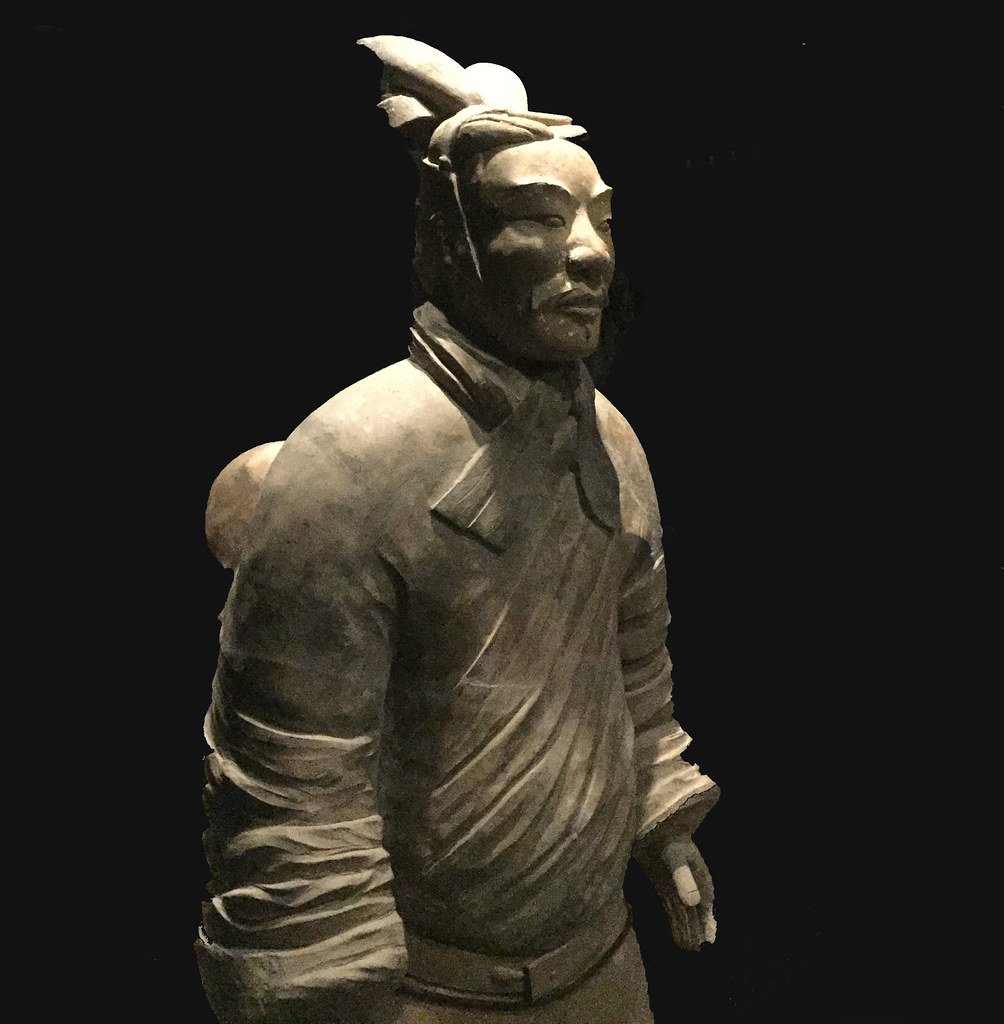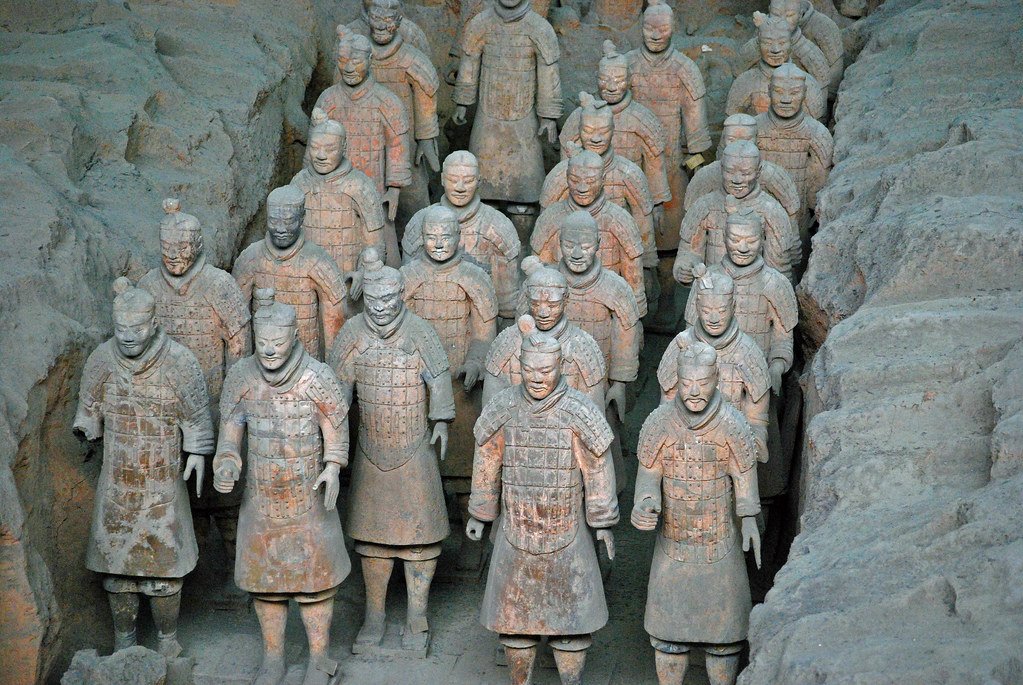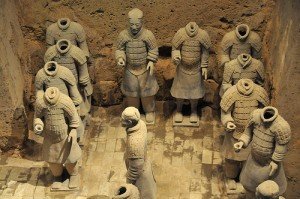Terracotta Army
The Terracotta Army, one of the world’s greatest archaeological discoveries, draws millions of visitors annually to Xi’an. This incredible site, which honors China’s first emperor, Qin Shi Huang, provides a fascinating window into ancient China’s art, culture, and military organization. Here’s a detailed guide to help you make the most of your visit to this extraordinary site.
Table of Contents
Why the Terracotta Army Should Be on Every Traveler’s China Itinerary
The Terracotta Army is a testament to the ambition and grandeur of ancient China. With over 8,000 life-sized soldiers, each with a unique appearance, the army offers an impressive showcase of craftsmanship and historical significance. The site allows visitors to immerse themselves in the world of Emperor Qin Shi Huang, witnessing the meticulous details that went into preparing him for the afterlife.

Uncovering the History: How the Terracotta Army Was Discovered
In 1974, local farmers digging a well near Xi’an uncovered fragments of terracotta warriors, leading to one of the most significant archaeological finds of the 20th century. The site contained thousands of clay soldiers, all commissioned by Qin Shi Huang to guard him in the afterlife. This discovery provides incredible insights into the military practices, religious beliefs, and artistry of the Qin Dynasty.
Emperor Qin Shi Huang’s Ambitious Vision
As the founder of a unified China, Emperor Qin Shi Huang is remembered for his ambitious projects, such as the Great Wall. His desire for immortality drove him to create an underground world, complete with a life-sized army, palaces, and rivers of mercury. The Terracotta Army represents just one part of a vast underground complex that has yet to be fully explored due to preservation concerns.
Exploring the Main Pits of the Terracotta Army
The Terracotta Army is organized into three main pits, each revealing unique aspects of ancient China’s military hierarchy.
Terra Cotta Pit No.1 was discovered by local villagers in March 1974 who were drilling for wells on a piece of barren land. They found fragments of terracotta warriors and many bronze weapons. These discoveries received much attention and the State Administration of Cultural Heritage sent a team of archaeologists and conservation experts to perform a site visit, and organized Shaanxi archaeologists to perform a full-scale excavation of the site.
In order to protect the find, a large arched hall with a steel frame was built above the pit in 1976. Covering an area of 19,136 square yards, the hall has provided the pit with good ventilation and daylight conditions. In addition, it is burglarproof and fireproof and has temperature and humidity monitoring systems.
Inside the hall, Terra Cotta Pit No.1 is an east-west rectangular pit, measuring 252 yards long, 68 yards wide and 16 feet deep. There are five sloping entrances on both the eastern and western sides. Two side doors are installed on the northern and southern sides. Every three yards, there is a puddle wall, which separates the underground army into different columns. The walls were fortified with wooden columns, earth and reeds while the floor was covered with black bricks. Visitors to the pit will notice that the walls are lower than the terracotta warriors. This is due to a flood in Pit 1 which caused the walls to partially collapse.
There are over 6,000 terra cotta warriors and horses in Pit 1, of which 1,000 have been unearthed. They are marshaled into a well-organized battle array composed of the infantry and cavalry. The vanguard includes 210 foot soldiers divided equally into three lines. The cavalry and war chariot follow close in line, forming the main body of the battle formation. The foot soldiers are alternated with the chariots drawn by horses, lined into 38 columns. On both the northern and southern sides of the war formation stand 180 warriors which serve as flank guards. The rear guards are on the western end, with two lines facing east and another facing west. Some soldiers are armed with battle robe, and some are equipped with armor.
The war formation in Pit No.1 is elaborately set in a line and is posed so to seem prepared for battle at any moment. Every soldier and horse warrior is life-like, recapturing the formidable array of Emperor Qin Shi Huang. One can only marvel at the grand artistic ability of the remote Qin Dynasty.
During the excavation, in addition to the terracotta warriors and horses, archeologists discovered a variety of different weaponry including bronze swords, spears, crossbows, arrows and Wugou. Wugou is a type of sword produced in the State of Wu under the order of King Helu. The edge of the Wugou is curved and sharp. This feature distinguishes it from the other weaponry found in the pit.
According to the records, the construction of the terracotta warrior pits began in 221BC when China was united. During the peasant uprisings in 209BC, construction halted and at the end of the Qin Dynasty, Xiang Yu set fire to the pit, which caused the pit to collapse and many terracotta warriors and horses were destroyed.
The Pit No.2 in Xian Qin Terra Cotta Warriors Museum is located 22 yards to the northeast of Terra Cotta Pit No.1. Covering an area of 7,176 square yards, it is L-shaped, measuring 136 yards from east to west, 107 yards from north to south, and sixteen feet deep.
Pit No.2 is the most spectacular of the three pits. Compared to Pit No.1, the combat formations in Pit No.2 are more complex, and the units of armed forces are more complete. According to preliminary calculations, there are over 80 war chariots, about 1,300 terra cotta warriors and horses, and thousands of bronze weapons. It is a revelation to first discover the terra cotta general, the kneeling archer and the warrior with saddle horse in the pit. There are two sloping entrances on the northern side, and four on both ends of the eastern and western sides.
The pit can be divided into four sections.
Section 1: Lying in the eastern corner of the pit, this section has a square shape. There are four corridors around the four sides where 60 crossbowmen are in standing posture. In the center of the square, there are four east-west passageways where 160 crossbowmen are aligned in squatting position.
Section 2: Lying in the right of the pit, section 2 measures 57 yards from east to west and 52 yards from north to south. Sixty-four war chariots make up a combat formation, which is divided into eight rows. Each of the chariots is pulled by four life-sized terra-cotta horses. Three warriors are side by side behind the chariot, with the middle one driving the carriage and the others standing on either side.
Section 3: In the center of the pit, is a rectangular combat formation made up of 264 foot soldiers and eight cavalrymen, as well as 19 war chariots. There are three clusters. One cavalryman stands in front of a horse with one hand drawing a bow and the other hand holding the rein. Additionally, there are between eight and thirty-six foot soldiers standing in each chariot.
Section 4: In the left of the pit, there are three east-west passageways where all the cavalrymen are aligned. The section measures 55 yards from east to west and 25 yards from north to south. The four sections make up an impregnable fortress. Next to the pit, there is a large exhibition hall which has the most complete range of functions and is where visitors can directly witness the excavation work in Pit 2.
The bronze swords unearthed in Pit 2 measure 86cm (34 inches) long and are carved with eight symmetrical facets. Buried for over 2,000 years, they are still very sharp and smooth. What’s more surprising is that the pliability of these bronze swords is extraordinarily good. One of the swords was found bent with a 331 pound terracotta warrior on top of it. When the heavy warrior figure was removed, the sword slowly returned to its original shape.
The swords were analyzed by scientists using modern methods. They concluded that the surfaces of these Qin swords were coated with an oxide film 10 microns thick which contained 2% chrome. This is especially noteworthy since the chrome oxidation technology wasn’t actually mastered until recent times and requires both complex equipment and processes. How did the Qin people do it more than 2,000 years ago? It’s a pity that their secret recipe was not been passed down to today. We can only marvel at the extraordinary casting technique and artistic standards during that period, and at the same time do our best to unveil the mystery.
Walk 27 yards northwest from Pit 1 and visitors will arrive at Terra Cotta Warrior Pit No. 3. Covering an area of 622 square yards, it is actually a component of both Terracotta Warriors Pit 1 and Terracotta Warriors Pit 2. Built in the shape of the Chinese character “凹”, it measures 19.2 yards long from east to west, 23.4 yards wide from north to south and 15.7 feet deep.
Experts have pointed out that Pit 3 is the command center or headquarters for all the groups in the other two pits. The unearthed artifacts include 68 terracotta warriors, four horses and one chariot all arranged in a layout that is quite unique. There is a slopping passageway in the east and upon entering it, you will face a chariot and horse chamber where there is a single war chariot. This chariot and horse chamber has two corridors on the two sides. A wing room is located to the west of the left corridor. To the west of the right corridor, there are antehall and back room. All the 68 warrior figures stand orderly along the two sides of the passageways.
What’s even more exciting is that various kinds of bronze weaponry as well as gold, stone and bronze decorations were also discovered here. Most of weapons used in actual combat such as bronze spears, bronze swords, crossbows and arrowheads are well preserved.
But one thing that puzzles experts very much is that there is no terra cotta warrior of the commander-in-chief. Actually, the terra cotta warriors include fully armored foot soldiers, cavalry, chariot soldiers and crossbowmen as mentioned before. Some experts maintain that a general would take the place of the commander-in-chief in the Qin wars. Some believe that the Emperor Qin Shi Huang himself is the commander-in-chief, and his image can not be replicated in the pit in order to defend the emperor’s dignity and absolute authority. But both sayings are conjecture, and experts are doing their best to discover the true reason.
Why many of the Qin Terracotta Warriors unearthed in the Pit 3 do not have heads?
It is believed that these warriors did have heads when they were originally produced. Archaeologists specul ated that at some point vandals broke into this pit and deliberately destroyed the warriors. During the archaeological excavation, a villager revealed that he dig out half of a warrior’s head in the southern wall of what is now the Qin Terracotta Warriors Museum. He returned the head and archaeologists searched across the various body pieces for a match. Finally, they matched it to a warrior body discovered in the Pit 3. This is one example of how many of the heads have been lost outside of the pit.
Although Pit 3 is smaller than both Pit 1 and Pit 2, archaeologists spent all of 1977 finishing the excavation of this pit. Because its contents were not burned like those in the other pits, the terracotta warriors unearthed in this pit are more splendid than those found in the other two.
Essential Highlights and Artifacts Not to Miss
Beyond the warriors, the Terracotta Army site features an array of artifacts that shed light on the Qin Dynasty’s advanced craftsmanship and military prowess.
- Bronze Chariots: These intricately designed chariots are considered masterpieces of ancient Chinese metalwork and offer insight into the technology and artistry of the Qin era.
- Original Weapons: Many weapons found at the site are well-preserved, thanks to a protective chromium coating. These weapons illustrate the sophistication of Qin’s military equipment.
- Armors and Uniforms: The detailed armor and uniforms found on the soldiers indicate the army’s hierarchy, with different designs representing various ranks.

Tips for Planning Your Visit to the Terracotta Army
Best Time to Visit
To avoid large crowds, plan your visit for early morning or late afternoon. The best months to visit are April through June and September through November, when the weather is pleasant and ideal for sightseeing.
How to Get There
The Terracotta Army is approximately 40 kilometers east of Xi’an. Here are your best transportation options:
- Public Bus: Buses 5 (306) and 307 from Xi’an Railway Station take you directly to the site.
- Taxi: A taxi ride from Xi’an city center is convenient and takes around one hour.
- Private Tours: Many visitors choose guided tours for a hassle-free experience, which typically includes transportation and an expert guide.
Ticket Information and Opening Hours
- Opening Hours: From 8:30 AM to 5:00 PM (November to March) and 8:30 AM to 5:30 PM (April to October).
- Ticket Prices: Tickets generally cost 120 RMB for adults, with discounts available for students, seniors, and children.

Practical Tips for an Enriching Experience
- Allocate Sufficient Time: To fully explore the pits, museum, and other areas, plan to spend at least 2-3 hours at the site.
- Hire a Knowledgeable Guide: A guide can provide in-depth insights into the history, architecture, and significance of the Terracotta Army, enhancing your experience.
- Dress Comfortably: Wear comfortable shoes and bring a hat or sunscreen, especially in the summer, as the pits are extensive.
- Respect the Rules: Photography is allowed, but avoid using flash to preserve the site’s delicate artifacts.
FAQs About Visiting the Terracotta Army
1. Is it possible to see Emperor Qin Shi Huang’s actual tomb?
No, the tomb itself has not been excavated due to concerns about preservation. The burial mound can be viewed from a distance, but the actual tomb remains hidden.
2. What amenities are available at the site?
The Terracotta Army complex includes restaurants, cafes, and souvenir shops near the entrance, allowing visitors to enjoy local snacks or pick up memorabilia.
3. Can I bring food and drinks inside?
Bringing water is recommended, as the visit may last a few hours. Some areas of the site may restrict food, so it’s best to check local policies upon arrival.

Why the Terracotta Army is Worth the Journey
The Terracotta Army provides a unique glimpse into China’s ancient past, blending artistry, history, and cultural significance. Standing before the Terracotta soldiers, you’ll experience the vision and power of Qin Shi Huang’s legacy. This site invites visitors into the depths of ancient China, making it an essential stop on any China itinerary. Whether you’re an enthusiast of history, art, or culture, the Terracotta Army offers a rare opportunity to connect with a defining era in Chinese history.
Call: (+86) 135 7702 4672 | Email: sales@travelchinawith.me
© Copyright 2012 - 2024, TravelChinaWith.Me | Hosting by ChemiCloud








